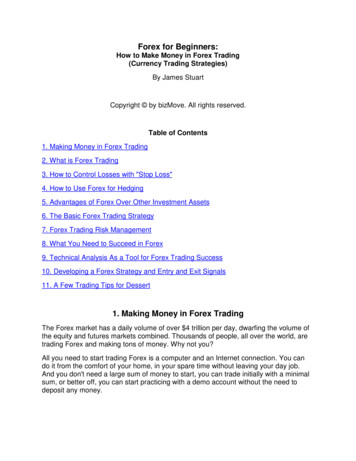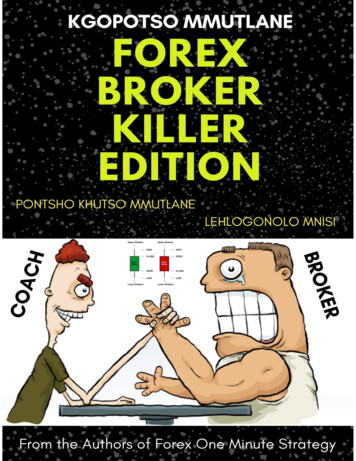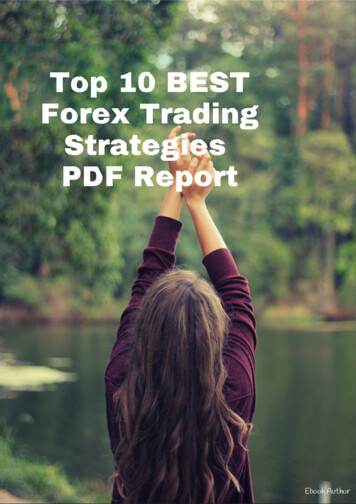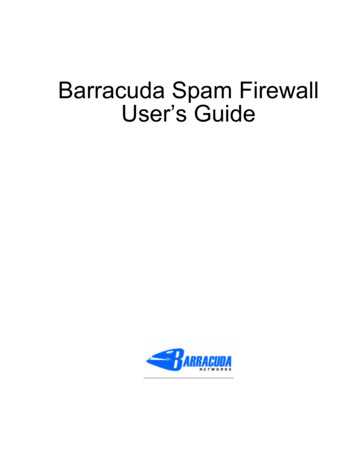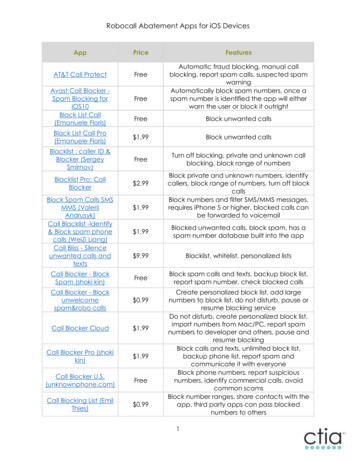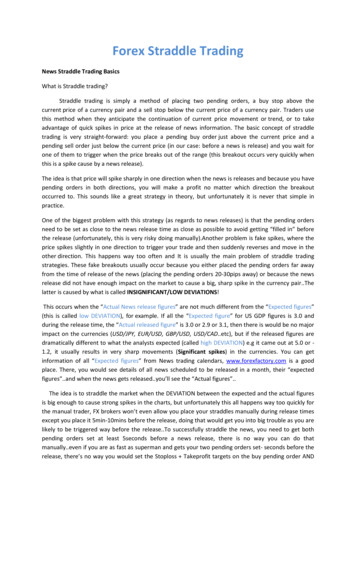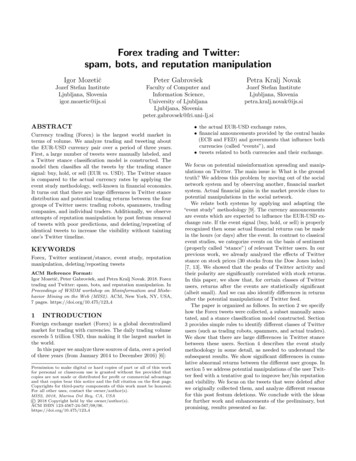
Transcription
Forex trading and Twitter:spam, bots, and reputation manipulationIgor MozetičPeter GabrovšekPetra Kralj NovakJozef Stefan InstituteLjubljana, Sloveniaigor.mozetic@ijs.siFaculty of Computer andInformation Science,University of LjubljanaLjubljana, Sloveniapeter.gabrovsek@fri.uni-lj.siJozef Stefan InstituteLjubljana, Sloveniapetra.kralj.novak@ijs.siABSTRACTCurrency trading (Forex) is the largest world market interms of volume. We analyze trading and tweeting aboutthe EUR-USD currency pair over a period of three years.First, a large number of tweets were manually labeled, anda Twitter stance classification model is constructed. Themodel then classifies all the tweets by the trading stancesignal: buy, hold, or sell (EUR vs. USD). The Twitter stanceis compared to the actual currency rates by applying theevent study methodology, well-known in financial economics.It turns out that there are large differences in Twitter stancedistribution and potential trading returns between the fourgroups of Twitter users: trading robots, spammers, tradingcompanies, and individual traders. Additionally, we observeattempts of reputation manipulation by post festum removalof tweets with poor predictions, and deleting/reposting ofidentical tweets to increase the visibility without taintingone’s Twitter timeline.KEYWORDSForex, Twitter sentiment/stance, event study, reputationmanipulation, deleting/reposting tweetsACM Reference Format:Igor Mozetič, Peter Gabrovšek, and Petra Kralj Novak. 2018. Forextrading and Twitter: spam, bots, and reputation manipulation. InProceedings of WSDM workshop on Misinformation and Misbehavior Mining on the Web (MIS2). ACM, New York, NY, USA,7 pages. https://doi.org/10.475/123 41INTRODUCTIONForeign exchange market (Forex) is a global decentralizedmarket for trading with currencies. The daily trading volumeexceeds 5 trillion USD, thus making it the largest market inthe world.In this paper we analyze three sources of data, over a periodof three years (from January 2014 to December 2016) [6]:Permission to make digital or hard copies of part or all of this workfor personal or classroom use is granted without fee provided thatcopies are not made or distributed for profit or commercial advantageand that copies bear this notice and the full citation on the first page.Copyrights for third-party components of this work must be honored.For all other uses, contact the owner/author(s).MIS2, 2018, Marina Del Rey, CA, USA2018 Copyright held by the owner/author(s).ACM ISBN 123-4567-24-567/08/06.https://doi.org/10.475/123 4 the actual EUR-USD exchange rates, financial announcements provided by the central banks(ECB and FED) and governments that influence bothcurrencies (called “events”), and tweets related to both currencies and their exchange.We focus on potential missinformation spreading and manipulations on Twitter. The main issue is: What is the groundtruth? We address this problem by moving out of the socialnetwork system and by observing another, financial marketsystem. Actual financial gains in the market provide clues topotential manipulations in the social network.We relate both systems by applying and adapting the“event study” methodology [9]. The currency announcementsare events which are expected to influence the EUR-USD exchange rate. If the event signal (buy, hold, or sell) is properlyrecognized then some actual financial returns can be madein the hours (or days) after the event. In contrast to classicalevent studies, we categorize events on the basis of sentiment(properly called “stance”) of relevant Twitter users. In ourprevious work, we already analyzed the effects of Twitterstance on stock prices (30 stocks from the Dow Jones index)[7, 13]. We showed that the peaks of Twitter activity andtheir polarity are significantly correlated with stock returns.In this paper, we show that, for certain classes of Twitterusers, returns after the events are statistically significant(albeit small). And we can also identify differences in returnsafter the potential manipulations of Twitter feed.The paper is organized as follows. In section 2 we specifyhow the Forex tweets were collected, a subset manually annotated, and a stance classification model constructed. Section3 provides simple rules to identify different classes of Twitterusers (such as trading robots, spammers, and actual traders).We show that there are large differences in Twitter stancebetween these users. Section 4 describes the event studymethodology in some detail, as needed to understand thesubsequent results. We show significant differences in cumulative abnormal returns between the different user groups. Insection 5 we address potential manipulations of the user Twitter feed with a tentative goal to improve her/his reputationand visibility. We focus on the tweets that were deleted afterwe originally collected them, and analyze different reasonsfor this post festum deletions. We conclude with the ideasfor further work and enhancements of the preliminary, butpromising, results presented so far.
MIS2, 2018, Marina Del Rey, CA, USA2TWITTER STANCE MODELTweets related to Forex, specifically to EUR and USD, wereacquired through the Twitter search API with the following query: “EURUSD”, “USDEUR”, “EUR”, or “USD”. Inthe period of three years (January 2014 to December 2016)almost 15 million tweets were collected. A subset of them(44,000 tweets) was manually labeled by knowledgeable students of finance. The label captures the leaning or stanceof the Twitter user with respect to the anticipated move ofone currency w.r.t. the other. The stance is represented bythree values: buy (EUR vs. USD), hold, or sell. The tweetswere collected, labeled and provided to us by the Sowa Labscompany (http://www.sowalabs.com).The labeled tweets were generalized into a Twitter stancemodel. For supervised learning, variants of SVM [15] are oftenused, because they are well suited for large scale text categorization, are robust, and perform well. For Forex tweets, weconstructed a two plane SVM classifier [11]. The two planeSVM assumes the ordering of stance values and implementsordinal classification. It consists of two SVM classifiers: Oneclassifier is trained to separate the ‘buy’ tweets from the‘hold-or-sell’ tweets; the other separates the ‘sell’ tweets fromthe ‘buy-or-hold’ tweets. The result is a classifier with twohyperplanes that partitions the vector space into three subspaces: buy, hold, or sell. During classification, the distancesfrom both hyperplanes determine the predicted stance value.The stance classifier was evaluated by 10-fold blocked crossvalidation. Since tweets are time-ordered, they should notbe randomly selected into individual folds, but retained inblocks of consecutive tweets [3]. The results of performanceevaluation are in Table 1. Note that the F1 measure considersjust the ‘buy’ and ‘sell’ classes, as is common in the threevalued sentiment classification evaluations [11].MeasureValueAccuracy 0.811 0.014F1 (𝑏𝑢𝑦, 𝑠𝑒𝑙𝑙) 0.810 0.014Table 1: Evaluation results of the Twitter stancemodel.3TWITTER USER GROUPSDifferent types of Twitter users have very different intentionsregarding their impact and message they want to spread. Inrecent years, specially automated robots became increasinglyinfluential. To properly estimate the relation between theForex market and tweetosphere, it is important to focus onrelevant Twitter users, i.e., Forex trading companies andindividual traders.In related work, it was already shown that bots exercise aprofound impact on content popularity and activity on Twitter. For example, Gilani et al. [8] implemented a simple botdetection mechanism based on click frequency and user agentstrings. To classify users into three categories (organizations,journalists/media bloggers, and individuals), De ChoudhuryI. Mozetič et al.et al. [5] trained an automatic classifier. An alternative approach is to detect communities in a retweet network, e.g.,[4, 14].It turns out that it is easy to identify Forex trading robots.Their tweets (𝑡(𝑏𝑜𝑡𝑠)) all start with one of the eighth patterns(such as “Closed Buy”, “Sell stop”, .). The Forex Twitterusers can then be classified into one of the four groups bythe following simple rules: Trading robots:𝑡(𝑏𝑜𝑡)𝑟𝑎𝑡𝑒 0.75 Spam/scam/advertisements:𝑡𝑤𝑒𝑒𝑡𝑠 1000 & ��𝑜 0.01 Trading companies:𝑑𝑎𝑦𝑠𝑎𝑐𝑡𝑖𝑣𝑒 30 & 𝑡𝑟𝑎𝑡𝑒 0.5 & ��𝑜 0.25 Individual traders:𝑑𝑎𝑦𝑠𝑎𝑐𝑡𝑖𝑣𝑒 30 & ��𝑜 0.05where 𝑡𝑟𝑎𝑡𝑒 ���𝑖𝑣𝑒 indicates the daily activityof the user, and ��𝑜 ���𝑡𝑠 is theproportion of the user tweets that were retweeted by others.Figure 1 shows the proportions of different Twitter usergroups and their tweets in our dataset. We can see that morethan half of the users are individuals, but that the tradingrobots produce by far the largest fraction of Forex tweets.Figure 1: Proportions of Twitter accounts and tweetsfor different user groups.There are also considerable differences in the stance between different user groups. Figure 2 shows that tradingrobots produce almost exclusively polarized tweets (no ‘hold’tweets). On the other hand, spammers (without robots) arepredominantly neutral (relatively few ‘buy’ or ’sell’ tweets).The groups we focus on, trading companies and individuals,are more opinionated than spammers. It is interesting thatin their tweets the ‘sell’ signal is prevailing, probably due tothe downward trend of EUR vs. USD in the last three years.
Forex trading and Twitter:spam, bots, and reputation manipulationMIS2, 2018, Marina Del Rey, CA, USAFigure 2: Twitter stance distribution of different user groups (bars show the proportion of tweets). Tradingrobots produce almost exclusively polarized tweets while spammers are predominantly neutral.4EVENT STUDYAn event study captures the impact of external events onthe market returns. External events that we consider hereare the currency related announcements by the central banks(FED and ECB) and governments (around 750 in the threeyears). In an event study, Cumulative Abnormal Return(CAR) is defined as a measure of return which exceed theoverall market return. Specifically: Market model corresponds to the overall marketmovement before the event. In our case, we use a linearregression of 30 days currency ratios prior to the event.The market model price is then subtracted from theactual currency price (at one minute resolution) to getthe abnormal price (𝑝𝑎𝑏):𝑝𝑎𝑏𝑖 𝑝𝑖 𝑘 * 𝑖where 𝑝𝑖 is actual price at time 𝑖 after the event. Abnormal return is computed as a relative (abnormal) price change:𝑟𝑎𝑏𝑖 𝑝𝑎𝑏𝑖 1 𝑝𝑎𝑏𝑖𝑝𝑎𝑏𝑖 Cumulative abnormal return (CAR) measuresaggregated returns over longer periods of time 𝑖:𝐶𝐴𝑅 𝑛 ︁𝑟𝑎𝑏𝑖𝑖 0The other essential component of an event study is determining the type of event in terms of its expected impact onthe price. In stock market, typically Earnings Announcementsare studied. If an announcement exceeds prior expectationsof analysts, it is classified as positive, and stock prices are expected to rise. An event study combines announcements aboutseveral stocks, over longer period of time, and computes theaverage CARs in the days or hours after the announcements.In our case, we do not consider expectation of the analysts,but instead use the stance of the Forex Twitter users regarding the EUR vs. USD exchange rate. We consider all tweets inone hour after the announcement, and aggregate their stanceto categorize the event. Then we compute the CARs for up toone day after the event, at one minute resolution. If Twitterstance correctly predicts the exchange rate movement thenthere should be some tangible returns (CARs) in the hoursafter the event.Figure 3 shows returns, aggregated over all 750 events,for different Twitter user groups. The expected result isvisible for trading companies (bottom-left chart). For ‘buy’events (we buy EUR at time 0) CARs are positive (return isaround 0.1%, small but significant), for ‘sell’ events (we sellEUR at time 0) CARs are negative , and for ‘hold’ events(no transaction) CARs are around zero. Similar results areobtained for individual traders (bottom-right chart), but theseparation of events is not as clear as for trading companies.On the other hand, trading robots and spam users (toptwo charts in Figure 3) show no useful correlation betweenthe Twitter stance and CARs. As a consequence, we concludethat it is important to properly identify them and eliminatetheir tweets from any trading strategy based on Twitter.
MIS2, 2018, Marina Del Rey, CA, USAI. Mozetič et al.Figure 3: Cumulative abnormal returns (CARs) for different user groups. The events are classified as ‘buy’,‘hold’, or ‘sell’ according to the cumulative Twitter stance in one hour after the event. The event is announcedat lag 0. CARs are computed at one minute resolution, for up to one day (1440 minutes) after the event.5REPUTATION MANIPULATIONHere we focus on another aspect of Twitter misuse for potential manipulation: post festum deletion of tweets by theTwitter user. What are the reasons for users to delete theirtweets? Previous research addressed prediction of maliciousor deleted tweets [1, 10, 12], and identification of deleted andsuspicious accounts [16]. On one hand, some authors showthat typos and rephrasing are among the major causes fordeleting tweets [1]. On the other hand, other authors foundthat in deleted tweets, a significantly higher fraction of thevocabulary consists of swear words, and markers that indicateanger, anxiety, and sadness [2].We verified which of the tweets that were collected duringthe three years in near real time, still exist. It turns out thatin our dataset, 4.7% (689,658) posts were post festum deletedby the users. Different user groups exhibit different patternsof deletion. A histogram in Figure 4 shows fractions of tweetsdeleted by different user groups. The majority of users donot delete their own tweets at all (peak at 0). At the otherextreme (100), there is about 5% of the users who deletedtheir accounts and all their tweets. But the really interestingare the trading companies, where only one third of them doesnot delete tweets, and more than half of them delete up to10% of their tweets.We focus on the deleted tweets by trading companies andindividual traders and search for signs of reputation manipulations. A breakdown of deleted tweets for both groups interms of different stances is in Table 2.
Forex trading and Twitter:spam, bots, and reputation manipulationMIS2, 2018, Marina Del Rey, CA, USAand 10% of their tweets. We analyze the deleted tweets andfocus on criteria that might indicate reputation manipulation.Figure 4: Fractions of tweets deleted for differentuser groups.User groupBuyHoldSellTradingcompanies453 (2.3%)3,285 (2.4%)1,297 (2.4%)Individualtraders4,438 (4.1%) 35,915 (7.3%) 11,572 (5.5%)Table 2: The number of deleted tweets of differentstance.5.1Deleting tweets to increase CARsOne reason for companies and individuals to delete theirtweets might be to create an image of their capabilities topredict the market. For example, one can post two contradictory tweets at the same time: EUR will go up, and EUR willgo down. After the market shows the actual EUR move, theincorrect prediction is deleted, and the user’s timeline showshis forecasting insight.We compare the results of the event study before and afterthe tweets were deleted. Figure 5 shows CARs for tradingcompanies and individual traders after removing their deletedtweets. At this point, we can report only negative results,i.e., there is no increase of CARs, and the ‘hold’ events arefurther away from the zero line than in Figure 3.5.2Figure 6: The fractions of deleted tweets (altogether3,741 tweets) for the 189 trading companies.Out of the 3,741 deleted tweets, 3,611 are unique (sameauthor and identical text) while 130 tweets are deleted morethan once. An extreme case is a tweet (advertising easy andsafe profit) which is deleted 46 times (same author and identical text). The deleting and reposting of identical tweets isone form of increasing visibility without tainting the author’sTwitter timeline. A tweet that is deleted and posted againappears several times in the user’s followers feed while it appears just once in the authors timeline. This can be thereforeconsidered a kind of reputation manipulation. Out of the93 tweets that were deleted and reposted, 50 were deletedand reposted once while the rest were deleted and repostedseveral times. The 746 ‘recommendation’ tweets that weredeleted afterward point to a potential reputation manipulation by deleting the bad recommendations. The breakdownof deleted tweets is shown in Figure 7.Analyzing trading companiesWe analyze deleted tweets of 189 (out of 195) Twitter userscategorized as trading companies that have active Twitteraccounts (by deleting an account, all the tweets from thataccount are also deleted). The 189 companies deleted 3,741tweets. Among them, four deleted all Forex related tweetsfrom their profile while the accounts are still active, 8 usersdeleted between 10% and 40% of their tweets, 33 users deletedbetween 1% and 5% of their tweets, and only 68 did not deleteany tweets. The deleting behaviour of trading companies isshown in Figure 6. Note that the majority (76% of the tradingcompanies) deleted less than 1% of their tweets. Note alsothat there are no trading companies that delete between 5Figure 7: A breakdown of deleted tweets by tradingcompanies.One of the major reasons to delete tweets are typos andrephrasing [1]. In these cases, a very similar tweet to thedeleted tweet is posted again. We check for each of the 3,575
MIS2, 2018, Marina Del Rey, CA, USAI. Mozetič et al.Figure 5: Cumulative abnormal returns (CARs) for trading companies and individual traders, after removingthe tweets that were post festum deleted by the user.tweets that were deleted once and not reposted, if they weredeleted due to a typo. We define typo as a reason of tweetdeletion if the tweet is: posted by the same author, within the three next tweets after the deleted one, with a very similar text (1 Levenshtein distance 4), and the difference is not in the URLs present in thetweet.We found that 122 deleted tweets were reposted with changesso small that indicate typos.Another category of deleted tweets are retweets. If retweetsare deleted, it is usually because the original tweets weredeleted. In our dataset, 406 retweets are deleted.We check the remaining 3,437 tweets for the use of vocabulary specific for trading: long, short, bear, bull, bearish,bullish, resistance, support, buy, sell, close. We identify 746tweets that are recommendations for trading (manually confirmed). This is another kind of possible reputation manipulation: a tweet with recommendation is posted and afterwards,if the recommendation turns out to be spurious, the tweet isdeleted. The author’s Twitter timeline then falsely appearsas if following his recommendations would yield profit.We inspect a specific Twitter account from the categorytrading companies that posted more than 500 tweets anddeleted between 10% and 40% of them. The identity of theaccount cannot be revealed due to the privacy issues. Thetweets deleted fall into the following categories: Reposts: 91, 60 of them are advertisements (e.g., subscribe for analysis), Links (to recommendations): 17, Recommendations: 11, Retweet: 1 (if the original tweet is deleted, retweetsare also deleted).We manually checked each of the 11 recommendationsthat were deleted. In all the cases, the recommendationsturned out to be bad, i.e., an investor would loose money. An(anonymized) example of a bad recommendation post is thefollowing:”@user mention while daily candle is above 1.xyz we arebullish on EURUSD.”while in the actual Forex market, EUR went down.This user used both types of reputation manipulation:deleting poor recommendations, and deleting/reposting ofidentical tweets to increase their visibility. The percentage ofdeleted poor predictions is small compared to all the deletedtweets and compared to all the posted tweets. We speculatethat the manipulation by tweet deletion needs to be subtle togo unnoticed by the users’ followers. However, even a subtlereputation burst in a domain as competitive as Forex tradingcan bring major benefits to the deceptive user.6CONCLUSIONSThis is an initial study of potential misuses of Twitter toinfluence the public interested in Forex trading. We identifydifferent types of Twitter accounts that are posting tweetsrelated to the EUR-USD currency exchange. We show thatthere are considerable differences between them in terms ofTwitter stance distribution and CARs. If we eliminate tradingrobots and spam, we find significant correlations between theTwitter stance and CARs (the returns are small, but the Forexmarket has very low trading costs). The remaining posts comefrom the Forex trading companies and individual traders. Wefurther analyze the reasons for post festum deleting of tweets.Some reasons are harmless (such as correcting typos), butsome show indications of reputation busting. We considerthis a promising direction for further, more in-depth analysis.
Forex trading and Twitter:spam, bots, and reputation manipulationAcknowledgementsThe authors acknowledge financial support from the H2020FET project DOLFINS (grant no. 640772), and the SlovenianResearch Agency (research core funding no. P2-103).REFERENCES[1] Hazim Almuhimedi, Shomir Wilson, Bin Liu, Norman Sadeh,and Alessandro Acquisti. 2013. Tweets are forever: a large-scalequantitative analysis of deleted tweets. In Proceedings of the2013 conference on Computer supported cooperative work. ACM,897–908.[2] Parantapa Bhattacharya and Niloy Ganguly. 2016. CharacterizingDeleted Tweets and Their Authors. In ICWSM. 547–550.[3] V. Cerqueira, L. Torgo, J. Smailović, and I. Mozetič. 2017. Acomparative study of performance estimation methods for timeseries forecasting. In Proc. 4th Intl. Conf. on Data Science andAdvanced Analytics. IEEE, 529–538. https://doi.org/10.1109/DSAA.2017.7[4] D. Cherepnalkoski and I. Mozetič. 2016. Retweet networks ofthe European Parliament: Evaluation of the community structure.Applied Network Science 1 (2016), 2. https://doi.org/10.1007/s41109-016-0001-4[5] Munmun De Choudhury, Nicholas Diakopoulos, and Mor Naaman.2012. Unfolding the event landscape on twitter: classification andexploration of user categories. In Proceedings of the ACM 2012conference on Computer Supported Cooperative Work. ACM,241–244.[6] P. Gabrovšek. 2017. Analysis of relations between currency marketand social networks. (2017). http://eprints.fri.uni-lj.si/3922[7] P. Gabrovšek, D. Aleksovski, I. Mozetič, and M. Grčar. 2017.Twitter sentiment around the Earnings Announcement events.PLoS ONE 12, 2 (2017), e0173151. https://doi.org/10.1371/journal.pone.0173151[8] Zafar Gilani, Reza Farahbakhsh, and Jon Crowcroft. 2017. Do Botsimpact Twitter activity?. In Proceedings of the 26th InternationalConference on World Wide Web Companion. International WorldWide Web Conferences Steering Committee, 781–782.[9] A Craig MacKinlay. 1997. Event studies in economics and finance.Journal of economic literature (1997), 13–39.[10] Juan Martinez-Romo and Lourdes Araujo. 2013. Detecting malicious tweets in trending topics using a statistical analysis oflanguage. Expert Systems with Applications 40, 8 (2013), 2992–3000.[11] I. Mozetič, M. Grčar, and J. Smailović. 2016. Multilingual Twittersentiment classification: The role of human annotators. PLoSONE 11, 5 (2016), e0155036. https://doi.org/10.1371/journal.pone.0155036[12] Sasa Petrovic, Miles Osborne, and Victor Lavrenko. 2013. I wishi didn’t say that! analyzing and predicting deleted messages intwitter. arXiv preprint arXiv:1305.3107 (2013).[13] G. Ranco, D. Aleksovski, G. Caldarelli, M. Grčar, and I. Mozetič.2015. The effects of Twitter sentiment on stock price returns.PLoS ONE 10, 9 (2015), e0138441. https://doi.org/10.1371/journal.pone.0138441[14] B. Sluban, J. Smailović, S. Battiston, and I. Mozetič. 2015. Sentiment leaning of influential communities in social networks. Computational Social Networks 2 (2015), 9. https://doi.org/10.1186/s40649-015-0016-5[15] Vladimir N. Vapnik. 1995. The Nature of Statistical LearningTheory. Springer.[16] Svitlana Volkova and Eric Bell. 2017. Identifying Effective Signalsto Predict Deleted and Suspended Accounts on Twitter AcrossLanguages. In ICWSM. 290–298.MIS2, 2018, Marina Del Rey, CA, USA
Forex, Twitter sentiment/stance, event study, reputation manipulation, deleting/reposting tweets ACM Reference Format: Igor Mozetiˇc, Peter Gabrovˇsek, and Petra Kralj Novak. 2018. Forex trading and Twitter: spam, bots, and reputation manipulation. In Proceedings of WSDM workshop on
